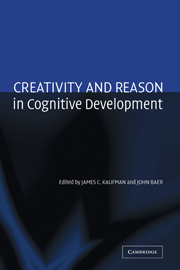Book contents
- Frontmatter
- Contents
- List of Contributors
- Acknowledgments
- Creativity and Reason in Cognitive Development
- Introduction
- COGNITIVE PERSPECTIVES
- 1 Expertise and Reason in Creative Thinking: Evidence from Case Studies and the Laboratory
- 2 Creative Genius, Knowledge, and Reason: The Lives and Works of Eminent Creators
- 3 Dynamic Processes Within Associative Memory Stores: Piecing Together the Neural Basis of Creative Cognition
- 4 The Creativity of Everyday Moral Reasoning: Empathy, Disgust, and Moral Persuasion
- 5 Reasoning and Personal Creativity
- 6 Alternative Knowledge Structures in Creative Thought: Schema, Associations, and Cases
- 7 The Role of the Knowledge Base in Creative Thinking
- 8 The Role of Domain Knowledge in Creative Problem Solving
- 9 Creative Thinking and Reasoning: Can You Have One Without the Other?
- 10 From Alexithymia, Borne of Trauma and Oppression, to Symbolic Elaboration, the Creative Expression of Emotions, and Rationality
- 11 Opening up Creativity: The Lenses of Axis and Focus
- DEVELOPMENTAL AND EDUCATIONAL PERSPECTIVES
- Author Index
- Subject Index
- References
4 - The Creativity of Everyday Moral Reasoning: Empathy, Disgust, and Moral Persuasion
Published online by Cambridge University Press: 19 January 2010
- Frontmatter
- Contents
- List of Contributors
- Acknowledgments
- Creativity and Reason in Cognitive Development
- Introduction
- COGNITIVE PERSPECTIVES
- 1 Expertise and Reason in Creative Thinking: Evidence from Case Studies and the Laboratory
- 2 Creative Genius, Knowledge, and Reason: The Lives and Works of Eminent Creators
- 3 Dynamic Processes Within Associative Memory Stores: Piecing Together the Neural Basis of Creative Cognition
- 4 The Creativity of Everyday Moral Reasoning: Empathy, Disgust, and Moral Persuasion
- 5 Reasoning and Personal Creativity
- 6 Alternative Knowledge Structures in Creative Thought: Schema, Associations, and Cases
- 7 The Role of the Knowledge Base in Creative Thinking
- 8 The Role of Domain Knowledge in Creative Problem Solving
- 9 Creative Thinking and Reasoning: Can You Have One Without the Other?
- 10 From Alexithymia, Borne of Trauma and Oppression, to Symbolic Elaboration, the Creative Expression of Emotions, and Rationality
- 11 Opening up Creativity: The Lenses of Axis and Focus
- DEVELOPMENTAL AND EDUCATIONAL PERSPECTIVES
- Author Index
- Subject Index
- References
Summary
At first glance, morality has nothing in common with creativity. It has long been clear to many philosophers that moral judgment (at least the right kind of moral judgment) is achieved through the careful and consistent application of moral principles. This approach is grounded in a school of thought that has long dominated the study of ethics – one that sees reason as the only proper foundation for moral judgment. In the 20th century, this tradition deeply influenced the study of moral judgment within psychology. The most influential theories of moral development in children, for instance, saw the development of moral judgment as being largely contingent upon the development of cognitive skills – as the quality of reasoning improves, so does the quality of moral judgment.
If one holds an exclusively reason-based view of moral judgment, then creativity applies to moral judgment as much as it does to simple arithmetic – not at all. This is because creativity is not rule based, but rule breaking. Creativity is about flexibility and innovation. Creative thinking demonstrates fluency, flexibility, and originality (Torrance, 1959). It is a type of problem solving characterized by its use of novel solutions (Newell, Simon, & Shaw, 1958). If moral reasoning entails the strict application of rules, creativity has nothing to do with it.
So why then would a volume devoted to creativity and reasoning include a contribution on moral reasoning?
- Type
- Chapter
- Information
- Creativity and Reason in Cognitive Development , pp. 81 - 98Publisher: Cambridge University PressPrint publication year: 2006
References
- 33
- Cited by

